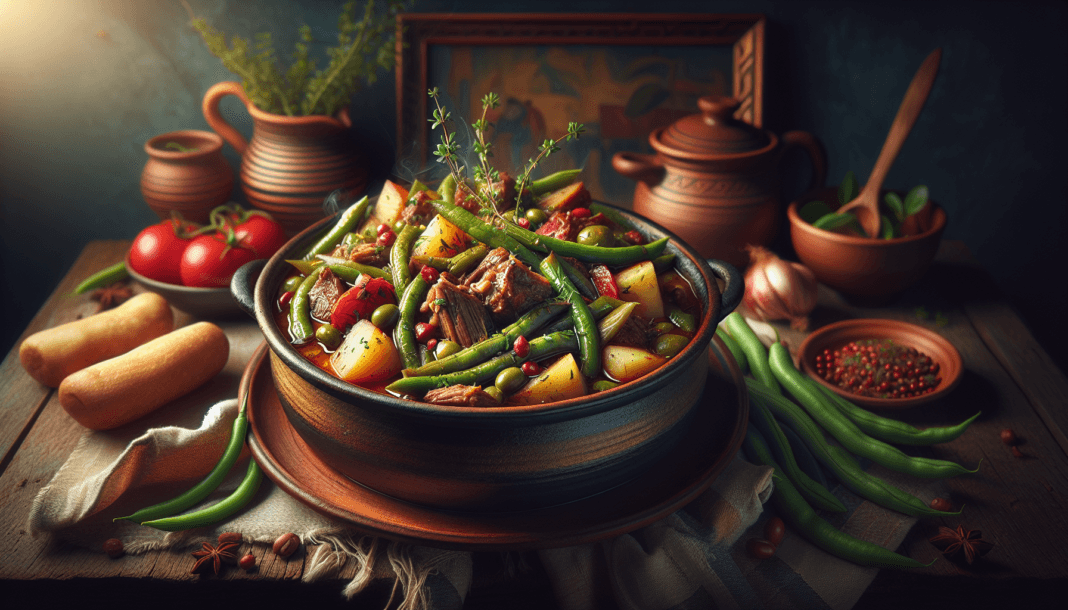Classic Fasolakia: A Taste of Greek Comfort
If you’re on the lookout for a warm, comforting dish that embodies the heart of Mediterranean cooking, look no further than Classic Fasolakia. This traditional Greek green bean stew is not only a delight to the palate but also a feast for the eyes. With its vibrant colors and inviting aroma, Fasolakia is a staple in Greek households—made with fresh green beans, ripe tomatoes, and a blend of herbs that create a truly exceptional savory dish.
Whether you’re new to the world of Greek cuisine or a seasoned cook looking to expand your recipe repertoire, Fasolakia is perfect for anyone who appreciates healthy, hearty meals that are accessible and sustainable. Join me as we delve into the rich flavors and history of this classic dish!
Who is this Recipe For?
Fasolakia is ideal for anyone who loves to indulge in plant-based meals that are not only rich in flavor but also healthy and nourishing. It’s perfect for vegetarians, vegans, and anyone trying to reduce their meat consumption, while still providing a satisfying and filling experience. This dish is also a fantastic option for those seeking comfort food with a Mediterranean twist. Whether you’re cooking for family, hosting friends, or meal prepping for the week, Classic Fasolakia is a fantastic choice that brings everyone together at the dinner table.
Ingredients You’ll Need
To create this Classic Fasolakia, you’ll want to gather the following ingredients:
Main Ingredients:
- Fresh Green Beans: 1 pound, trimmed
- Tomatoes: 4 medium-sized, diced (or one 14 oz can of diced tomatoes)
- Onion: 1 large, chopped
- Garlic: 3 cloves, minced
- Carrot: 1 large, sliced
- Olive Oil: 1/4 cup
- Fresh Parsley: 2 tablespoons, chopped (for garnishing)
- Salt and Pepper: to taste
- Water or Vegetable Broth: 2 cups
- Optional: Pinch of dried oregano or thyme for extra flavor
Kitchen Equipment Needed
Before you dive into making Classic Fasolakia, ensure you have the following kitchen equipment on hand:
- Large pot or Dutch oven
- Cutting board
- Chef’s knife
- Wooden spoon
- Measuring cups and spoons
Directions to Make Classic Fasolakia
Step 1: Prepare Your Ingredients
Start by prepping your vegetables. Trim the green beans, chop the onion, mince the garlic, and slice the carrot. If using fresh tomatoes, dice them as well.
Step 2: Sauté the Onion and Garlic
In a large pot or Dutch oven, heat the olive oil over medium heat. Add the chopped onion and sauté for about 4-5 minutes, until it becomes translucent. Then add the minced garlic and sauté for an additional minute, allowing the aroma to fill your kitchen.
Step 3: Add the Vegetables
Once your onion and garlic are ready, incorporate the sliced carrot and green beans into the pot. Stir to combine and let them cook for about 5 minutes, allowing the green beans to soften slightly.
Step 4: Add the Tomatoes and Liquid
Now, it’s time to add your diced tomatoes and the water or vegetable broth. If you’re adding dried herbs for extra flavor, sprinkle them in at this point. Stir everything well and bring the mixture to a boil.
Step 5: Simmer the Stew
Once boiling, decrease the heat to low. Cover your pot and let it simmer for about 25-30 minutes, or until the green beans are tender and the flavors meld beautifully. Remember to check in occasionally, stirring gently to prevent sticking.
Step 6: Season and Serve
Once your Fasolakia is cooked to perfection, add salt and pepper to taste. Ladle the stew into bowls and garnish with fresh chopped parsley. Serve warm, preferably with crusty bread on the side!
Tips for Making the Best Fasolakia
Fresh vs. Canned Tomatoes: While fresh tomatoes lend a delightful flavor, canned tomatoes can save time and still taste great. Choose San Marzano for their sweet taste if going the canned route.
Add Protein: If you want to make this dish heartier, consider adding chickpeas or lentils during the simmering step.
- Spicy Kick: For those who enjoy a bit of heat, try adding a pinch of red pepper flakes along with the garlic.
Storage and Leftovers
If you have any leftovers, you can store them in an airtight container in the refrigerator for up to 4 days. Fasolakia is often considered even better the next day, as the flavors continue to develop. If you want to keep it longer, consider freezing the stew. Simply let it cool completely, then portion it into freezer-safe containers. It can be stored in the freezer for up to 3 months.
To reheat, simply thaw in the refrigerator overnight, then warm it gently on the stove or in the microwave until heated through.
Serving Suggestions
Classic Fasolakia shines on its own, but you can make the meal even more special with a few pairings:
- Bread: A warm, crusty loaf or pita complements the stew perfectly for dipping.
- Feta Cheese: Crumbled feta adds a tangy flavor that balances the sweetness of the dish.
- Wine Pairing: A glass of white wine, such as Sauvignon Blanc or a light-bodied red, pairs beautifully with Fasolakia, enhancing your dining experience.
Variations of Fasolakia
Though Classic Fasolakia is delicious as is, you can tailor it to your preferences:
- Fasolakia with Potatoes: Add diced potatoes during the simmer to make it heartier.
- Mediterranean Twist: Incorporate artichoke hearts or bell peppers for an added burst of flavor and texture.
FAQ Section
Can I make Fasolakia in advance?
Absolutely! This dish stores well and can be made a day or two in advance without losing flavor.
Is Fasolakia gluten-free?
Yes, Fasolakia is a naturally gluten-free dish as it is made entirely of vegetables and herbs.
Can I use frozen green beans?
While fresh green beans provide the best flavor, frozen green beans can be used in a pinch. Just adjust the cooking time as necessary, since frozen beans may require less time to cook through.
Call to Action
Are you ready to savor the comforting flavors of Classic Fasolakia? This recipe is versatile, wholesome, and perfect for sharing with loved ones! If you try it out, please share your experience in the comments below or tag me on social media. Don’t forget to share this recipe with friends and subscribe to the blog for more delicious recipes from around the world. Happy cooking!







